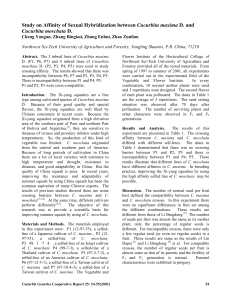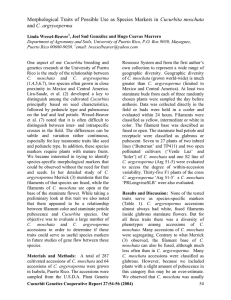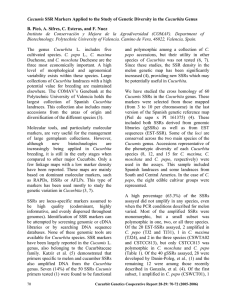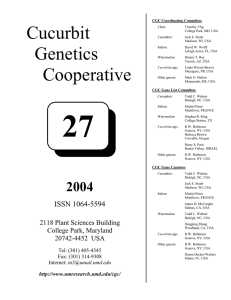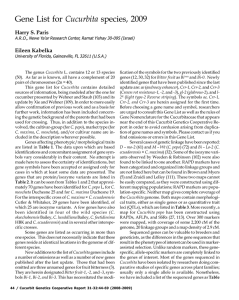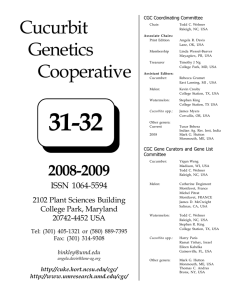Cucurbita maxima C. moschata
advertisement
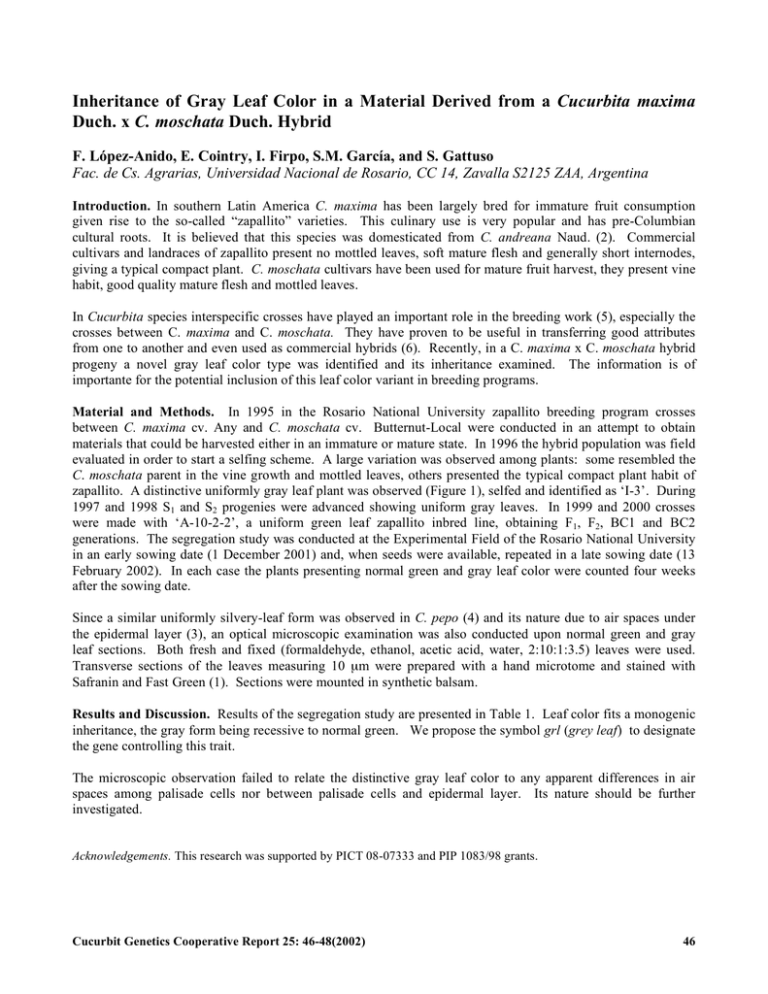
Inheritance of Gray Leaf Color in a Material Derived from a Cucurbita maxima Duch. x C. moschata Duch. Hybrid F. López-Anido, E. Cointry, I. Firpo, S.M. García, and S. Gattuso Fac. de Cs. Agrarias, Universidad Nacional de Rosario, CC 14, Zavalla S2125 ZAA, Argentina Introduction. In southern Latin America C. maxima has been largely bred for immature fruit consumption given rise to the so-called “zapallito” varieties. This culinary use is very popular and has pre-Columbian cultural roots. It is believed that this species was domesticated from C. andreana Naud. (2). Commercial cultivars and landraces of zapallito present no mottled leaves, soft mature flesh and generally short internodes, giving a typical compact plant. C. moschata cultivars have been used for mature fruit harvest, they present vine habit, good quality mature flesh and mottled leaves. In Cucurbita species interspecific crosses have played an important role in the breeding work (5), especially the crosses between C. maxima and C. moschata. They have proven to be useful in transferring good attributes from one to another and even used as commercial hybrids (6). Recently, in a C. maxima x C. moschata hybrid progeny a novel gray leaf color type was identified and its inheritance examined. The information is of importante for the potential inclusion of this leaf color variant in breeding programs. Material and Methods. In 1995 in the Rosario National University zapallito breeding program crosses between C. maxima cv. Any and C. moschata cv. Butternut-Local were conducted in an attempt to obtain materials that could be harvested either in an immature or mature state. In 1996 the hybrid population was field evaluated in order to start a selfing scheme. A large variation was observed among plants: some resembled the C. moschata parent in the vine growth and mottled leaves, others presented the typical compact plant habit of zapallito. A distinctive uniformly gray leaf plant was observed (Figure 1), selfed and identified as ‘I-3’. During 1997 and 1998 S1 and S2 progenies were advanced showing uniform gray leaves. In 1999 and 2000 crosses were made with ‘A-10-2-2’, a uniform green leaf zapallito inbred line, obtaining F1, F2, BC1 and BC2 generations. The segregation study was conducted at the Experimental Field of the Rosario National University in an early sowing date (1 December 2001) and, when seeds were available, repeated in a late sowing date (13 February 2002). In each case the plants presenting normal green and gray leaf color were counted four weeks after the sowing date. Since a similar uniformly silvery-leaf form was observed in C. pepo (4) and its nature due to air spaces under the epidermal layer (3), an optical microscopic examination was also conducted upon normal green and gray leaf sections. Both fresh and fixed (formaldehyde, ethanol, acetic acid, water, 2:10:1:3.5) leaves were used. Transverse sections of the leaves measuring 10 µm were prepared with a hand microtome and stained with Safranin and Fast Green (1). Sections were mounted in synthetic balsam. Results and Discussion. Results of the segregation study are presented in Table 1. Leaf color fits a monogenic inheritance, the gray form being recessive to normal green. We propose the symbol grl (grey leaf) to designate the gene controlling this trait. The microscopic observation failed to relate the distinctive gray leaf color to any apparent differences in air spaces among palisade cells nor between palisade cells and epidermal layer. Its nature should be further investigated. Acknowledgements. This research was supported by PICT 08-07333 and PIP 1083/98 grants. Cucurbit Genetics Cooperative Report 25: 46-48(2002) 46 Figure 1. Expanded normal green (left) and gray (right) leaves. Cucurbit Genetics Cooperative Report 25: 46-48(2002) 47 Table 1. Goodness of fit X2 test for normal green and gray leaf plant segregation evaluated in an early (E) and late (L) sowing date. Generation Sowing No. of plants Green Gray Expected Ratio X2 P 0.14 0.53 0.08 0.5-0.75 0.25-0.50 0.75-0.90 0.29 0.08 0.50-0.75 0.75-0.90 Date A-10-2-2 I-3-14-5 F1 (A-10-2-2 x I-3-14-5) F1 (I-3-14-5 x A-10-2-2) F2 (A-10-2-2 x I-3-14-5) F2 (I-3-14-5 x A-10-2-2) BC (A-10-2-2 x I-3-14-5) x A-10-2-2 BC (A-10-2-2 x I-3-14-5) x I-3-14-5 E L E L E L E E L E E L E L 30 16 26 16 31 113 36 27 37 47 45 27 49 42 35 15 8 40 25 1:0 1:0 0:1 0:1 1:0 1:0 1:0 3:1 3:1 3:1 1:0 1:0 1:1 1:1 Literature cited 1. Dizeo de Strittmatter, C. 1979. Modificación de una coloración de Safranina Fast-green. Bol. Soc. Arg. Bot. 18: 121-122. 4. Shifriss, O. 1982. On the silvery-leaf trait in Cucurbita pepo L. Cucurbit Genet. Coop. Rpt. 5:48-49. 2. Millan, R. 1945. Variaciones del zapallito amargo Cucurbita andreana y el orígen de Cucurbita maxima. Rev. Arg. Agron 12:86-93. 5. Whitaker, T. W. and G.W. Bohn. 1950. The taxonomy, genetics, production and uses of the cultivated species of Cucurbita. Econ. Bot. 4:52-81. 3. Scarchuk, J. and J.M. Lent. 1965. The structure of mottled-leaf summer squash. J. Hered. 56:167-168. Cucurbit Genetics Cooperative Report 25: 46-48(2002) 6. Whitaker, T. W. and R.W. Robinson. 1986. Squash breeding. In: Breeding Vegetables Crops. M.J. Bassett Ed. pp 209-242. AVI Publishing Co. 48





